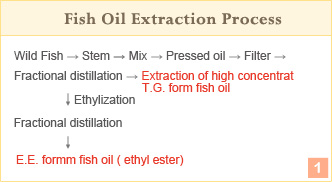| Home » Health Information
|
Are You Taking the Right Fish Oil?
n spite of all the news about health and nutrition in the media, current diets tend towards high fat intake. The word "fat" creates a health concern for many. However, consuming "good fat" does not increase body weight. Good fats also help to lower blood lipid and possess anti-inflammation properties. Of the good fats, omega-3 fatty acid in fish oil is the most beneficial.
Do you know how to select good quality fish oil? Most over the counter (OTC) fish oil contains organic solvents detrimental to our health. This type of fish oil consists of ethyl ester, which can dissolve Styrofoam™. How do we identify the difference between the one that dissolves Styrofoam™ and the natural form in order to select safe and effective fish oil?

 How Does Fish Oil Dissolve Styrofoam™?
How Does Fish Oil Dissolve Styrofoam™?
The ethyl ester form of fish oil dissolves Styrofoam™and natural high concentration triglyceride form of fish oil does not. During the ethyl ether fish oil manufacturing process other chemicals are added to reduce the cost, and this process produces an ethyl ester (EE) byproduct. (Picture 1)
During the manufacturing process modification of the structure of this type of esterified fish oil changes into highly concentrated EE form of fish oil (structure as below), and Styrofoam™ can dissolve in most organic solvents containing ester, alcohols, and ketone. Examples of this type of solvent include super glue and nail polish remover and the E.E. form of fish oil.
» EPA Triglycerides, molecular weight 302.5

» EPA ethyl ester, molecular weight 330.51

 What effect does ethyl ester form fish oil
have to our health?
What effect does ethyl ester form fish oil
have to our health?
Esterified fish oil has a larger molecular weight than natural fish oil, resulting in a lower absorption rate. (Picture 2) Also, esterified fish oil has a totally different chemical structure than natural fish oil, and performs different functions in the body. Many years of study by Professor Francesco Visioli specializing in the absorption rate between the EE and TG forms has been corroborated by other researchers.
The EE form of fish oil unfortunately harms rather than helps one's health. It can form alcohol and a byproduct (Picture 3) when hydrolyzed by stomach acid. Long term intake of the EE form demonstrates an inability to lower blood sugar and prevent cardiovascular disease. Rather the EE form of fish oil can cause health issues.
Fish oil that dissolves Styrofoam cannot be effectively used to lower blood lipid and cholesterol. Because the chemical solvent added during the manufacture process has changed its structure, resulting in artificial esters, methyl alcohol, ethyl alcohol, and ethyl acetate formation. Thus, when choosing fish oil, it is important to only choose the "T.G. form" fish oil.
| Picture 2 |
Bio-digestibility |
Dissolve Styrofoam |
| T.G. form |
DHA:57% , EPA:68% |
No |
| E.E. form |
DHA:20% , EPA:21% |
Yes |
| Ethyl Acetate |
| Structure |
 |
| Properties |
Ethyl acetate an inflammable volatile clear liquid easily hydrolyzed by acid into acetic acid and ethanol (alcohol) |
| Health concern |
Eye and respiratory system irritation. Inhaling high concentrations can cause acute pulmonary edema, liver and kidney damage. Continuous inhalation can cause respiratory paralysis. Misuse can cause nausea, vomiting, and abdominal pain etc. Long term exposure can cause allergy, bleeding gum, dermatitis, and leukocytosis. |








